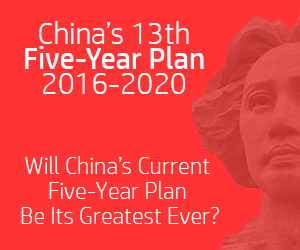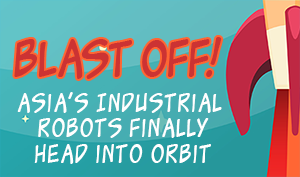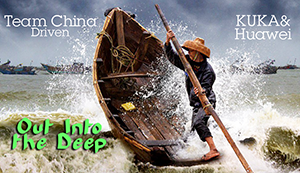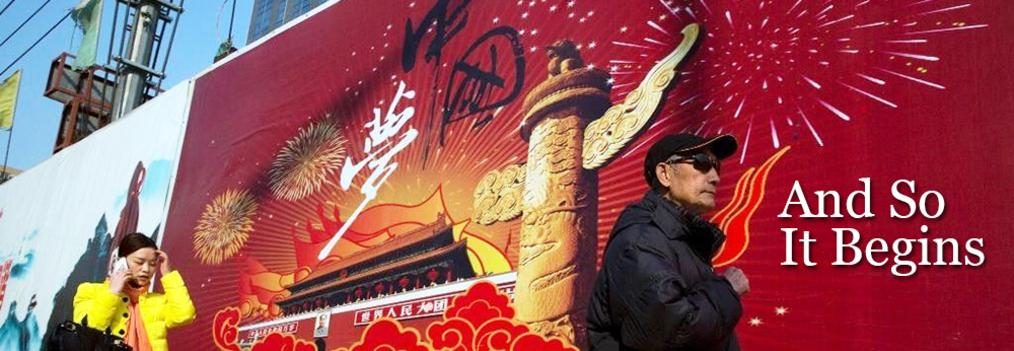
China’s Big Push: Xi, Robots and Productivity
Leap to manufacturing economy based on invention and technology demands increased productivity
“There are many criteria to judge whether a country is a manufacturing power or not, including industrial scale,
optimized industrial structure, sound quality and efficiency and sustainable development, but the key lies in innovation.”
—Li Beiguang, deputy head, Ministry of Industry and Technology (MIIT)
It’s all about innovation
The biggest country in Asia is about to pull off the biggest deployment of robot-driven automation in the world.
And by its own reckoning—Made in China 2025 and the 13th Five-Year Plan 2016-2020—it’ll all be done by 2025, which is more like a femtosecond compared to how long such colossal changes usually take humanity to complete.
Does any of it seem possible?
In reality, fast as they are, China can’t afford to spare any of those precious femtoseconds. A Financial Times article aptly titled,China manufacturing: Adapt or die, paints a gloomy scenario of the country’s awful economic slowdown and its ramifications for China, its people and any of its many of global trading partners.
The country is struggling and the rest of the world is holding its collective breath as China’s leaders attempt to simultaneously put the brakes on a national economy spiraling downward while undertaking massive change to its financial infrastructure, manufacturing and ways of doing business.
So why is all this happening to China? And is China alone in this economic whirlpool? See related: For Asia There’s No Turning Back
An accurate and concise summing up of China’s present dilemma can be found in Accenture’s Beyond capital and labor: The view from China’s productivity frontier:
“The country’s unparalleled growth since 1979 has been built largely at the intersection of two powerful forces: While tens of millions of new workers have flooded in from the countryside to power China’s industrial economy, the government has made huge investments in factories, urban infrastructure and heavy machinery. However, the country now faces a pair of major bottlenecks.
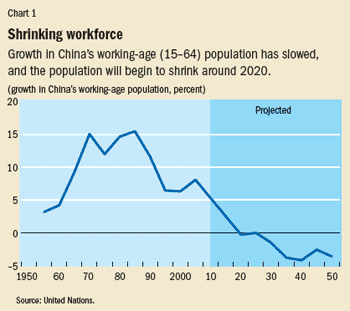 “First, its population is rapidly aging, and the size of the labor force is likely to plateau by 2016.
“First, its population is rapidly aging, and the size of the labor force is likely to plateau by 2016.
“Second, the pace of capital investment growth is expected to slow as Beijing seeks to re-balance the economy in favor of more consumption.
“China doesn’t have to accept slower growth as inevitable. But to avoid this, it must get more out of what it has—greater productivity from its people and more bang from its yuan. Both are achievable if policy makers and company leaders start to make changes now.”
That sets the stage for what is happening now
Factory China is in a desperate struggle from “decreasing demand, increasing competition from international competitors and developing countries, and slower domestic economy. The plan[Made in China 2025] is indeed the key to maintain the growth at a medium-to-high level and enhance the competitiveness of the manufacturing sector, which is facing new challenges such as environmental and resources, rising labor costs and a slowdown in investment and exports.”
 In his piece for the Financial Times, China seeks quantum leap to a new economic model, Charles Clover zeros in on China’s escape hatch through productivity: “China needs to boost productivity if it is to escape the “middle income trap” where a low wage manufacturing economy fails to make the leap to one based on invention and technology.
In his piece for the Financial Times, China seeks quantum leap to a new economic model, Charles Clover zeros in on China’s escape hatch through productivity: “China needs to boost productivity if it is to escape the “middle income trap” where a low wage manufacturing economy fails to make the leap to one based on invention and technology.
“However, multi-factor productivity, a broad proxy for innovation, is actually declining, accounting for just 30 per cent of GDP growth in the past five years—a fall from 40 to 48 percent from 1990-2010, according to McKinsey.”
President Xi Jinping and his brain trust are well aware of China’s dire straits, know what has to be done, and are moving ahead with all deliberate speed to transform the lives, work, and futures of 1.2 billion human beginnings.
The clarion sound bites from all of the media buzz and political rhetoric are three: technology and innovation lead to the essential productivity that offers safe passage to future of prosperity. Technology, innovation and productivity make the magic elixir…shaken, not stirred, of course, with lots of hard work.
McKinsey’s year-long study of what it calls China’s “productivity imperative” reasons further: “Improving innovation performance would have additional benefits—helping China’s transition to a more balanced, consumption-driven economy by expanding the service sector and providing more high value-added jobs. Rising productivity is also critical for creation of the well-paying jobs that can raise living standards and employ a growing urban population.”
That at the core of all this technology-innovation-productivity is robotics and robot-driven automation is a message to the rest of the world that it too will pass this way as well. Much sooner than later, every global economy will have to come to terms with productivity; the only difference being that China is just the first to take the journey. Those lessons learned should neither be minimized nor forgotten by any of the onlookers.
China's Robot
Revolution?
China: What's Ahead
Never Better! Selling Robots, Cobots, Grippers, AGVs & Parts in China
SMEs pick up $9.7 billion in government subsidies; guarantees on $73 billion in loans over the next three years (to 2022)
What If China Automated Its Cut-Flower Industry?
Cut-flower cultivation the size of New Jersey—with zero automation—is now worth $11 billion. An automated future could treble its value
Eyeing China, Japan Ramps Up Robot Production
Forecasts for a steady downturn in robot and automation sales suddenly reverse—with good reason!
Asia, Robots & the Jack Ma Effect
Asia’s best pitchman for robots, automation and disruptive transformation gets cranking
China Upgrades Logistics as Alibaba Goes Amazon
$14M investment in Geek+ is a modest but integral start for Alibaba’s $16 billion automation strategy
Consumption as China’s Cure-All: Robots, People & Lots of Money
What would gigawatts of consumer spending look like? Think, Singles’ Day every day!
China’s Retail Boom: Automation, Robots & Lingerie
Victoria’s Secret may need more than a glitzy fashion show in Shanghai to score big with China’s white-hot consumer marketplace
China Envy: AI, Robotics & All That Stuff
Should the U.S. be uneasy over China’s newfound AI power surge?
Siemens Encamps Global Robot Research HQ in China
Manufacturing gets an upgrade as robots, automation and manufacturing converge and merge

